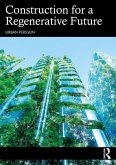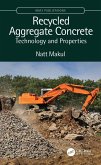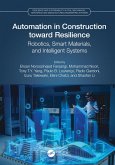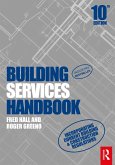Automation in Construction toward Resilience (eBook, PDF)
Robotics, Smart Materials and Intelligent Systems
Redaktion: Noroozinejad Farsangi, Ehsan; Li, Shaofan; Chatzi, Eleni; Takewaki, Izuru; Gardoni, Paolo; Lourenço, Paulo B.; Yang, Tony T. Y.; Noori, Mohammad


Alle Infos zum eBook verschenken

Automation in Construction toward Resilience (eBook, PDF)
Robotics, Smart Materials and Intelligent Systems
Redaktion: Noroozinejad Farsangi, Ehsan; Li, Shaofan; Chatzi, Eleni; Takewaki, Izuru; Gardoni, Paolo; Lourenço, Paulo B.; Yang, Tony T. Y.; Noori, Mohammad
- Format: PDF
- Merkliste
- Auf die Merkliste
- Bewerten Bewerten
- Teilen
- Produkt teilen
- Produkterinnerung
- Produkterinnerung

Hier können Sie sich einloggen

Bitte loggen Sie sich zunächst in Ihr Kundenkonto ein oder registrieren Sie sich bei bücher.de, um das eBook-Abo tolino select nutzen zu können.
This book presents all aspects of automation in construction pertaining to the use of information technologies in design, engineering, construction technologies, and maintenance and management of constructed facilities.
- Geräte: PC
- ohne Kopierschutz
- eBook Hilfe
- Größe: 71.21MB
![Construction for a Regenerative Future (eBook, PDF) Construction for a Regenerative Future (eBook, PDF)]() Urban PerssonConstruction for a Regenerative Future (eBook, PDF)44,95 €
Urban PerssonConstruction for a Regenerative Future (eBook, PDF)44,95 €![Recycled Aggregate Concrete (eBook, PDF) Recycled Aggregate Concrete (eBook, PDF)]() Natt MakulRecycled Aggregate Concrete (eBook, PDF)136,95 €
Natt MakulRecycled Aggregate Concrete (eBook, PDF)136,95 €![Automation in Construction toward Resilience (eBook, ePUB) Automation in Construction toward Resilience (eBook, ePUB)]() Automation in Construction toward Resilience (eBook, ePUB)76,95 €
Automation in Construction toward Resilience (eBook, ePUB)76,95 €![101 Case Studies in Construction Management (eBook, PDF) 101 Case Studies in Construction Management (eBook, PDF)]() Len Holm101 Case Studies in Construction Management (eBook, PDF)29,95 €
Len Holm101 Case Studies in Construction Management (eBook, PDF)29,95 €![Modern Methods of Construction and Innovative Materials (eBook, PDF) Modern Methods of Construction and Innovative Materials (eBook, PDF)]() Arthur LyonsModern Methods of Construction and Innovative Materials (eBook, PDF)38,95 €
Arthur LyonsModern Methods of Construction and Innovative Materials (eBook, PDF)38,95 €![Building Services Handbook (eBook, PDF) Building Services Handbook (eBook, PDF)]() Fred HallBuilding Services Handbook (eBook, PDF)40,95 €
Fred HallBuilding Services Handbook (eBook, PDF)40,95 €![Applying a Systems Thinking Approach to the Construction Industry (eBook, PDF) Applying a Systems Thinking Approach to the Construction Industry (eBook, PDF)]() Michael SiebertApplying a Systems Thinking Approach to the Construction Industry (eBook, PDF)29,95 €
Michael SiebertApplying a Systems Thinking Approach to the Construction Industry (eBook, PDF)29,95 €-
-
-
Dieser Download kann aus rechtlichen Gründen nur mit Rechnungsadresse in A, B, BG, CY, CZ, D, DK, EW, E, FIN, F, GR, HR, H, IRL, I, LT, L, LR, M, NL, PL, P, R, S, SLO, SK ausgeliefert werden.
- Produktdetails
- Verlag: Taylor & Francis
- Seitenzahl: 638
- Erscheinungstermin: 29. September 2023
- Englisch
- ISBN-13: 9781000912906
- Artikelnr.: 68596837
- Verlag: Taylor & Francis
- Seitenzahl: 638
- Erscheinungstermin: 29. September 2023
- Englisch
- ISBN-13: 9781000912906
- Artikelnr.: 68596837
Robots. 2. Robotics in 3D Concrete Printing: Current Progress & Challenges.
3. Reinforcement Learning-Based Robotic Motion Planning for Conducting
Multiple Tasks in Virtual Construction Environments. 4. The Impact of Smart
Materials on Structural Vibration Control. 5. Green Construction Workforce
Training using Virtual Reality. 6. Building Information Modeling (BIM) in
Geotechnics and Infrastructures. 7. Building Information Modeling
Implementation in the UK Construction Industry: A Commercial Perspective.
8. Towards Automated Quality Assurance: Generating Synthetic Images of
Building Components for Vision-based Semantic Segmentation. 9. Truss Bridge
Construction Using Self-Propelled Modular Transporters Compared to
Traditional Bridge Building Methods. 10. Bacteria-Based Self-Healing
Concretes for Sustainable Structures.11. Structural Health Monitoring as a
Tool toward More Resilient Societies. 12. Toward More Seismic Resilient
Construction via Risk-Based Application of Smart Vibration Control Systems.
13. Decision Systems to Support Cost-Benefit Analysis Toward Railway
Infrastructures Sustainable Rehabilitation. 14. Adaptive System Supervising
the Response Control for Smart Structures. 15. SiDMACIB: A Digital Tool for
Automated Structurally-Informed Design of Interlocking Masonry Assemblages.
. 16. Parametric Study of Low-Rise Buildings Using a Smart Hybrid Rocking
Structural System with Vertical Dampers. 17. Review of the Use of Waste
Resources in Sustainable Concrete: Aggregate Types, Recycling Procedures,
Fresh and Hardened Properties, Structural Characteristics, and Numerical
Formulation. 18. Seismic Multi-Hazard Risk and Resilience Modeling of
Networked Infrastructure Systems. 19. A Novel Design Method of Single TMD
Exposed to Seismic Effects. 20. Intelligent Controller Optimizing
Structural Performance and Control Devices. 21. Rapid Discrete Optimal
Design of High-Damping Rubber Dampers for Elastic-Plastic Moment Frames
Under Critical Double Impulse. 22. Damage Detection in Reinforced Concrete
Structures using Advanced Automatic Systems: An Overview. 23. Efficient
Representation of Random Fields for Training the Kriging Predictor in
Adaptive Kriging Reliability Assessment of Civil Structures. 24.
Intelligent Systems in Construction: Applications, Opportunities and
Challenges in AR & VR. 25. Smart Control of Flutter of Suspension Bridges
Using Optimized Passive Tuned Mass Damper. 26. A Chronological Review of
Construction Progress Monitoring Using Various Sensors and Remote Sensing
Techniques. 27. Review of Novel Seismic Energy Dissipating Techniques
Toward Resilient Construction. 28. Application of Machine Learning in
Design of Steel Plate Shear Walls. 29. Blast Mitigation of Irregular
Buildings Equipped with Resilient Passive Control Systems. 30. Fragility,
Resilience, Development and Investment: Two Decision-Making Tools to
Advance Economic and Social Development in Border Towns.
Robots. 2. Robotics in 3D Concrete Printing: Current Progress & Challenges.
3. Reinforcement Learning-Based Robotic Motion Planning for Conducting
Multiple Tasks in Virtual Construction Environments. 4. The Impact of Smart
Materials on Structural Vibration Control. 5. Green Construction Workforce
Training using Virtual Reality. 6. Building Information Modeling (BIM) in
Geotechnics and Infrastructures. 7. Building Information Modeling
Implementation in the UK Construction Industry: A Commercial Perspective.
8. Towards Automated Quality Assurance: Generating Synthetic Images of
Building Components for Vision-based Semantic Segmentation. 9. Truss Bridge
Construction Using Self-Propelled Modular Transporters Compared to
Traditional Bridge Building Methods. 10. Bacteria-Based Self-Healing
Concretes for Sustainable Structures.11. Structural Health Monitoring as a
Tool toward More Resilient Societies. 12. Toward More Seismic Resilient
Construction via Risk-Based Application of Smart Vibration Control Systems.
13. Decision Systems to Support Cost-Benefit Analysis Toward Railway
Infrastructures Sustainable Rehabilitation. 14. Adaptive System Supervising
the Response Control for Smart Structures. 15. SiDMACIB: A Digital Tool for
Automated Structurally-Informed Design of Interlocking Masonry Assemblages.
. 16. Parametric Study of Low-Rise Buildings Using a Smart Hybrid Rocking
Structural System with Vertical Dampers. 17. Review of the Use of Waste
Resources in Sustainable Concrete: Aggregate Types, Recycling Procedures,
Fresh and Hardened Properties, Structural Characteristics, and Numerical
Formulation. 18. Seismic Multi-Hazard Risk and Resilience Modeling of
Networked Infrastructure Systems. 19. A Novel Design Method of Single TMD
Exposed to Seismic Effects. 20. Intelligent Controller Optimizing
Structural Performance and Control Devices. 21. Rapid Discrete Optimal
Design of High-Damping Rubber Dampers for Elastic-Plastic Moment Frames
Under Critical Double Impulse. 22. Damage Detection in Reinforced Concrete
Structures using Advanced Automatic Systems: An Overview. 23. Efficient
Representation of Random Fields for Training the Kriging Predictor in
Adaptive Kriging Reliability Assessment of Civil Structures. 24.
Intelligent Systems in Construction: Applications, Opportunities and
Challenges in AR & VR. 25. Smart Control of Flutter of Suspension Bridges
Using Optimized Passive Tuned Mass Damper. 26. A Chronological Review of
Construction Progress Monitoring Using Various Sensors and Remote Sensing
Techniques. 27. Review of Novel Seismic Energy Dissipating Techniques
Toward Resilient Construction. 28. Application of Machine Learning in
Design of Steel Plate Shear Walls. 29. Blast Mitigation of Irregular
Buildings Equipped with Resilient Passive Control Systems. 30. Fragility,
Resilience, Development and Investment: Two Decision-Making Tools to
Advance Economic and Social Development in Border Towns.







